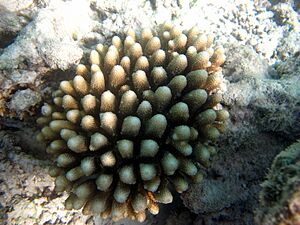Acropora monticulosa facts for kids
Quick facts for kids Acropora monticulosa |
|
|---|---|
 |
|
| Conservation status | |
| Scientific classification | |
| Synonyms | |
|
Acropora monticulosa is a type of coral that belongs to the acroporid family. You can find this coral in warm, shallow ocean waters. It lives in places like the southwest and northern Indian Ocean, the central Indo-Pacific, Australia, Southeast Asia, Japan, and the East China Sea. It's also found in the Tuamotus islands. This coral prefers tropical reefs on upper slopes, usually in water from 1 to 12 meters deep. It was first described by a scientist named Brüggemann in 1879.
What It Looks Like
Acropora monticulosa corals grow in large, dome-shaped groups called colonies. These colonies can be more than 3 meters wide! Their branches are thick and have a single tip at the end. The small cups on the branches, called corallites, are neatly arranged and all about the same size. This coral can be cream-colored or blue. It looks quite similar to two other coral species: Acropora globiceps and Acropora retusa.
Where It Lives and Why It Needs Help
This coral is listed as a "Near Threatened" species on the IUCN Red List. This means that its population is likely decreasing, and it might become endangered if things don't change. It's also protected under CITES Appendix II, which is an international agreement to help protect plants and animals that are threatened.
We don't know exactly how many of these corals are left. However, they are likely threatened by several things:
- The overall shrinking of coral reefs around the world.
- Rising ocean temperatures, which cause coral bleaching. This happens when corals get stressed and lose their color and food source.
- Climate change, which affects ocean conditions.
- Human activities, such as pollution and damage from boats or fishing.
- The Crown-of-thorns starfish (Acanthaster planci), which eats coral.
- Diseases that can affect corals.
You can find Acropora monticulosa in the northern and southwestern Indian Ocean, the central Indo-Pacific, Australia, Southeast Asia, Japan, the East China Sea, and the western Pacific Ocean. It also lives in the Tuamotus. These corals prefer tropical shallow reefs on upper slopes, living in depths between 1 and 12 meters.
How It Was Named
This coral was first described in 1879 by Brüggemann. He originally named it Madrepora monticulosa.


